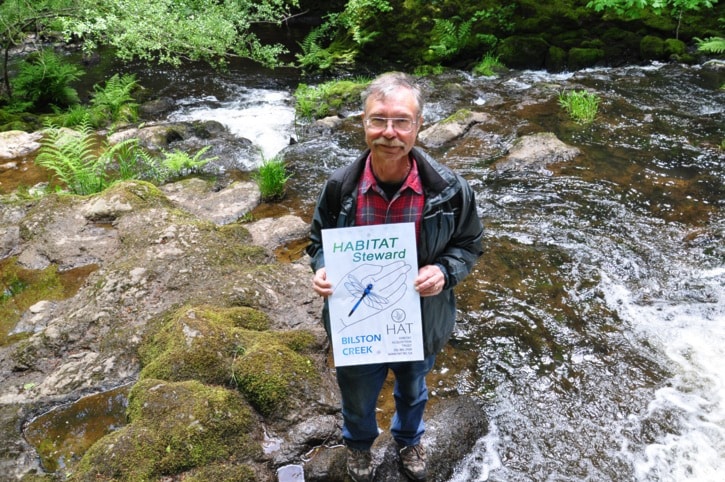In Witty’s Lagoon park, Bilston creek offers a picture of what nature should be –- a clear meandering stream, home to native cutthroat trout and thick with streamside vegetation.
A small dam built before living memory almost looks like an organic part of the river. Crisscrossed with fallen trees, it creates ideal shade and shelter for trout. It’s also a reminder of the long history of human influence on the creek.
“The dam is part of the history of Bilston. It functions just fine,” says Ian McKenzie, with the Bilston Watershed Habitat Protection Association, overlooking the pool, which may have been used as a drinking hole for cattle in the past. “It’s one of those things that adds character to the stream.”
The Bilston group has worked for decades on projects to restore the health of the creek from damage done in the 1980s and 90s. Now with residential development ever expanding within the 7,900 acres of the Bilston watershed, the creek and its tributaries are weathering the influence of rapid urbanization, particularly in Langford.
To stem the tide of pollutants, the Habitat Acquisition Trust, a non-profit land trust, is rolling out another phase of its “Good Neighbours” project within Bilston and North Latoria watersheds.
HAT is spreading the message that homeowners and hobby farmers can take relatively simple actions to keep the creek and watershed healthy, and is offering education and advice to interested residents.
“We want to prevent pesticides and nutrients from getting into the creek,” says Todd Carnahan, HAT’s Good Neighbours project leader. “We can identify problems and things people can do to keep the trout population healthy in the stream. We want people to be part of a place they value.”
In urban areas, being a steward can mean not using chemical pesticides on gardens and lawns, removing invasive plant species and allowing native streamside vegetation to flourish. On hobby farms, it can mean keeping livestock out of the creek and siting manure piles away from drainage areas.
“If there is beautiful streamside vegetation, we like people to leave it alone. Plants hold the soil, prevent run off and slow the release of water into natural streams,” Carnahan says. “Often the best thing is about doing nothing.”
Bilston creek and its many tributaries flow out of the green hills of Mount Wells Park and drain in Witty’s Lagoon some seven kilometres east. Shorter North Latoria creek flows out of Triangle Mountain to Albert Head.
Both systems collect pollutants as they wind around homes, farms, failing septic systems and roadways – the threat to watersheds is damage by a thousand paper cuts.
Carnahan says fish kills in North Latoria creek in recent years highlighted the need for public stewardship programs in Colwood, Langford and Metchosin. McKenzie says residential development in Langford is continually washing dirt into the creek.
“(Witty’s) lagoon is gradually filling with silt and will eventually become a field,” McKenzie says. “Langford has development guidelines in place, but still, there’s a lot of silt going into the stream.”
Silt and mud hurt spawning trout, who are native to the creek system and never leave, and have never had their numbers boosted by hatchery fish. Most of the Bilston enhancement projects over the years have been focused on creating better fish habitat –- healthy trout are a good indicator of the overall health of the watershed.
“There are a reasonable number of trout,” McKenzie says, “but they are at risk due to urban development.”
HAT is seeking homeowners to become stewards of Bilston and North Latoria watersheds. Call 250 995-2428 or drop by the HAT office at 827 Broughton St. See www.hat.bc.ca for more information.
For more information on the Bilston Watershed Protection Society, see www.bilstoncreek.org.
editor@goldstreamgazette.com
